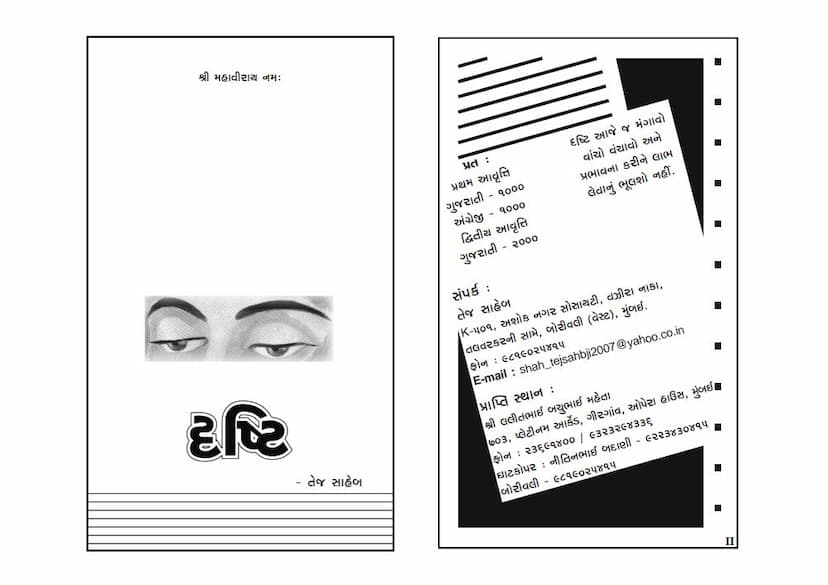Drusti
Added to library: September 1, 2025

Summary
This is a comprehensive summary of the Jain text "Drusti" by Tej Saheb, based on the provided pages and catalog link.
Book Title: Drusti (Vision/Perspective) Author: Tej Saheb Publisher: Tej Saheb Summary:
"Drusti" by Tej Saheb is a Jain text that delves into the profound importance of one's perspective (Drusti) in shaping their experience of the world and their spiritual journey. The central theme is that the world appears as heaven if one possesses a pure and clear vision. Conversely, a distorted perspective is considered the greatest flaw, and this can be corrected through the company of the wise and the study of good literature.
The book emphasizes that changing the world is often an insurmountable task, but changing one's vision is achievable and leads to profound transformations. When one's perspective becomes samyak (right or balanced), the true nature of reality begins to unfold. This shift in vision can even lead to experiencing a "heaven on earth" while still alive.
Tej Saheb presents "Drusti" as a culmination of his various writings, offered to society with the blessings of his spiritual guide. He acknowledges that if any part of the book deviates from Jain principles, he seeks forgiveness.
Key Themes and Concepts Explored:
- The Power of Vision: The book repeatedly highlights that our perception of the world is a direct reflection of our inner vision. What we see in others and in the world is often a projection of our own inner state, including our flaws.
- Correcting Vision: The text suggests that wisdom and good literature are crucial tools for purifying and correcting our vision.
- Internal Transformation over External Change: A fundamental message is that true change comes from within by altering our perspective, rather than trying to change external circumstances or people.
- The Significance of a Positive Approach: The author advocates for a positive outlook, which is essential for spiritual progress and experiencing happiness in life.
- Acceptance and Harmony: The concept of "Acceptance leads to Harmony" (Swikar tya samadhan) is a recurring theme. Embracing situations and accepting what is, is presented as a path to inner peace.
- Victory Over Inner Enemies: The text focuses on conquering internal adversaries like anger, pride, greed, and envy, recognizing them as the true obstacles to spiritual growth.
- Patience and Perseverance: The importance of dhiraj (patience) is stressed, especially in the context of spiritual practice and waiting for the results of actions.
- Empathy and Compassion: The book encourages seeing the good in others, even in those who may be considered flawed, and extending love and compassion to all beings, including sinners.
- The Role of Self-Reflection: The author advises individuals to focus on their own faults and self-improvement rather than criticizing others.
- Mindfulness and Control of the Mind: A significant portion of the text is dedicated to understanding and controlling the mind, which is described as fickle and prone to desires and anxieties.
- Detachment and Non-Possessiveness (Parigrah): The book advocates for shedding excessive attachment to material possessions and recognizing that true happiness lies in detachment.
- The Essence of Dharma: Dharma is repeatedly linked to purity of vision and the understanding of reality as it truly is.
- Humility and Modesty (Vinay): Humility is presented as a potent remedy for ego and a foundation for spiritual progress.
- Living a Meaningful Life: The text encourages living a life of purpose, contributing to society, and sharing one's happiness and resources with others.
- Understanding Karma and Destiny: The book touches upon the principles of karma and destiny, emphasizing that while certain events may be karmically determined, our response and effort (purusharth) are crucial.
- The Impermanence of Life and the Nature of Death: The text addresses the inevitability of death and encourages preparation for it by living a virtuous and dharmic life. It distinguishes between different types of death and emphasizes the importance of a conscious and peaceful departure.
- The Value of Contentment: The book underscores the principle of contentment (santosh) as a key to happiness and a path to overcoming desires.
- The Importance of Good Company and Right Guidance: The influence of companions and the need for guidance from spiritual teachers are highlighted.
- The Inner Journey: Ultimately, "Drusti" guides the reader towards an inward journey of self-discovery, urging them to look within for true happiness and liberation.
The book is rich with practical advice, anecdotes, and philosophical insights rooted in Jain teachings, aiming to guide readers toward a more meaningful, peaceful, and spiritually fulfilling life by refining their "Drusti."